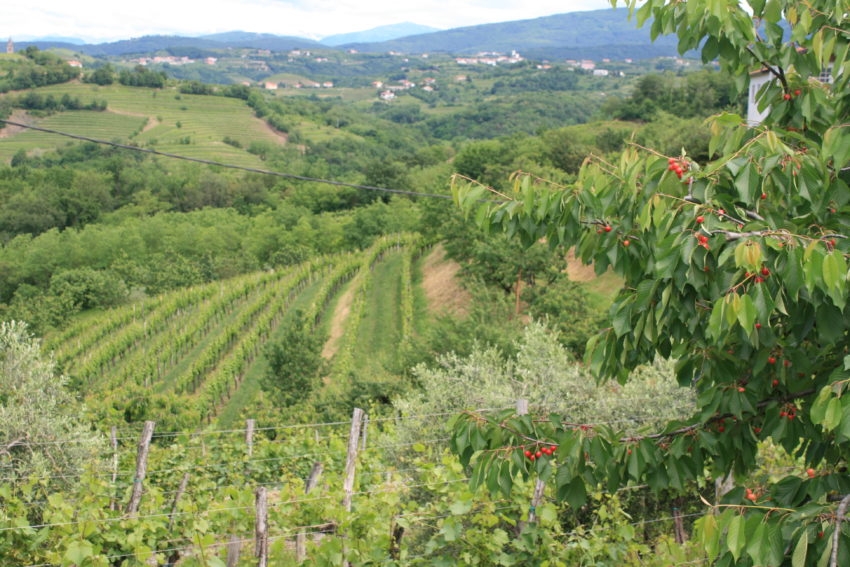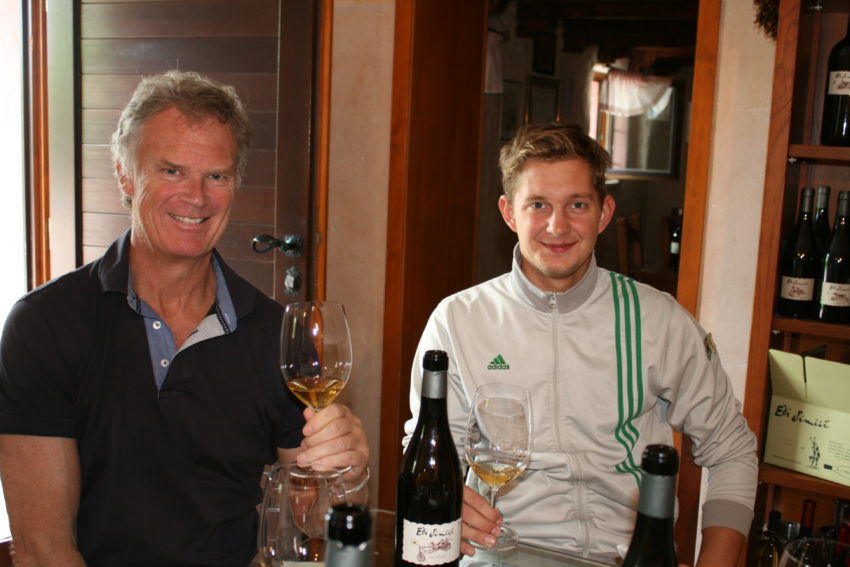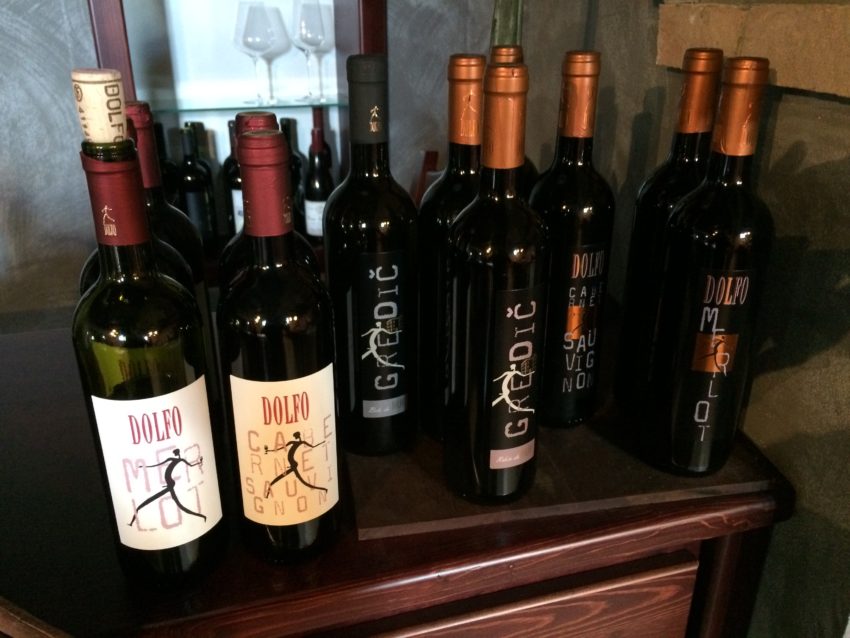Slovenia wines make you want to toast to democracy

KOZANA, Slovenia — I kid people that I tend to gravitate to former communist countries to get in touch with my inner Marxist. Somehow, Marxist doctrine and Stalinism are easier to digest with the appropriate alcohol. In Russia I drank vodka. In Czech Republic I drank beer. In Slovakia I drank a savage plum brandy called Slivovice which, I’m convinced, the USSR used to subdue all of Czechoslovakia. Here in Slovenia, I’m in more familiar territory. Slovenia is one of the most underrated wine nations in the world. After a week in this country, I got hooked like a piranha on a sommelier’s finger.
Look at a Europe map and you can see why Slovenia has great wine. It borders the Friuli Venezia Giulia region that produces such amazing Pinot Biancos in northeast Italy. Slovenia is the same latitude as the Burgundy region of central France. It’s part of wine’s conga line that wraps around the northern end of the Adriatic Sea. I was about to enter a new taste world full of Terans and Malvazijas and Rebulas. I might even find a decent Merlot. Imagine that.

As soon as I crossed the Slovenian border north of Trieste, Italy, I could tell I was in wine country. A light rain greeted me as I drove over rolling green hills lined with grapevines. I passed little villages with names I couldn’t pronounce and that were quickly in my rear-view mirror. Signs pointing down narrow roads toward wineries quickly began to appear.
I had passed into Goriska Brda, probably the most renowned district in the wine region of Primorska in western Slovenia. Get out a winery map of Brda and find the red dots representing wineries. It looks like a someone dripped a glass of Merlot over the map for 10 minutes. Wineries are everywhere.
It make sense. The Celts made wine in this area way back in the 5th century B.C. Slovenia has always produced high-quality wines but under the old Yugoslavian communist rule, production was limited. No one knew much about Slovene wines until after 1991 when Yugoslavia broke up into, eventually, eight countries and Slovenia started to export. I first fell in love with a Slovene Riesling at the massive VinItaly wine fair in Verona, Italy, in 2002. I’d see Slovene wines show up occasionally in high-end American bars with long wine lists or liquor stores the size of Madison Square Garden. Slovene wines are crisp, fruity and not very expensive.
Yet so few know about them. Traffic is so light at the wineries that my hotel owner had to call and make appointments so a winery rep would be at home. My first stop was a place called Edi Simcic. The short ride from my hotel in this tiny village of Kozana had fabulous panoramas of Slovenia’s rolling green countryside. I even stopped on the road to take a dozen photos. The shots were nearly as breathtaking as the realization that I left my 210-millimeter zoom lens on the hood of my car WHEN I DROVE AWAY!

Not realizing until after a day of wine drinking that I was out a couple hundred euro, I merrily drove to the village of Vipolze and down the narrow driveway to Edi Simcic (SEEM-chick). Jure Simcic, 22, was waiting in the driveway of a big house above a lone green line of grapevines. Simcic explained Slovene wines and his family’s winery in a small, neat showroom. Tall, lithe and blonde, Simcic could pass for a rising Slovene basketball player. Instead, he is a third-generation wine expert. But under Yugoslav rule, smaller vineyards had to give a percentage of their grapes to the big sellers. Otherwise, they’d have higher taxes. His grandfather, Edi Simcic, started the winery in 1991.

They have about 30 acres and 60,000 vines, small for a commercial winery, but they had less than five acres when this was Yugoslavia. They produce about 40,000 bottles a year and export 70 percent of their stock, mostly to the U.S. and China. Apparently, none goes to France.
“The Italians will try our wines,” Simcic said in perfect English. “But the French? Never.”
My first tasting was what would stay with me all week, like the first kiss of a beautiful woman. The Rebula is one of the Slovene wine scene’s crown jewels. Many wineries produce it, but the Simcics’ was especially delicious. Maybe it was walking past long rows of French oak barrels in their storage room or sipping above a wine vineyard added to it. But the Rebula is firm, crisp and full of yellow fruits like grapes and apricots. On a perfect 75-degree day, sipping a wine that will last me forever, I refused to believe that less than 25 years ago this was part of a communist country.
We moved onto another wine I’d later see dot menus across Slovenia. The Malvazija (Mal-vah-ZEE-ah) is mostly a Mediterranean grape but the Simcics have had no problems growing it here. It’s more gold than a Rebula and tastes drier. But it’s a full-flavor wine. It was like biting into a ripe peach.
Possibly the Simcics’ signature wine is the Duet Lex which is bottled for four years before being released. It’s heavy, about 14 percent alcohol. But its ruby red color and spicy flavor are absolutely spectacular. Looking through the wine splotches on my notepad, I see I scribbled two stars over the name. I was pretty accurate when I learned the price. It retails for 100 euros. The Simcics sold me a bottle for 37 which included the wine tasting.

I asked Simcic about the labels. Usually the quality of the wine is in direct opposite of the triviality of the label. If the label has drawings of dinosaurs or a sexy babe, it’s usually best served from a box. It’s like restaurants with great views. The vista will keep your mind off the steak you’ve been chewing for 20 minutes. The Simcics’ are different. Nearly all the labels have dogs doing things dogs normally do, like, you know, pound a drum (Rebula), play the trombone (Triton) and operate a three-wheeled bicycle (Malvazija).
“My grandfather,” Simcic said, “liked to be different.”

Continuing along the country road skirting the Italian border I came to Plesivo, home to Dolfo wines. The winery features comfy wooden furniture made from old wine barrels and great views of grapevines leading to the village beyond. Owner Marko Skocaj, a thick-necked, grizzled man with long hair parted far on the side, gave a brief tour. Smiling and laughing, Skocaj, 48, is like Juri Simcic. His grandfather also started his winery but theirs started in 1989, two years before Yugoslavia broke up.
He offered an array of samples, including the one I wanted most. I’d heard Slovenia produces one of Europe’s best Merlots. I wanted to try ONE decent Merlot. My experience with Merlots is from too many bad table wines in restaurants too cheap to upgrade or college bars that don’t know any better. Washington produces a good Merlot, and so does Italy but I can’t afford it. Merlot can be produced nearly anywhere, in mass quantities, and can be made cheap. It tastes it as my pounding head reminds me three hours after I drink the swill. When Paul Giamatti in “Sideways” shouted, “I’M NOT DRINKING FUCKING MERLOT!” no more poignant line was ever said in Hollywood.
I can afford Slovenia’s. It’s 16 euros and worth every penny. It was simply the best Merlot of my life, full of plums and pomegranates and berries. It’s also dry so I could imagine eating it with roast beef instead of a cheeseburger I once ate it with in Gainesville, Fla. I moved on to a Spirito (70 percent Chardonnay, 30 percent Pinot Noir and very much like a Prosecco but better), a Chardonnay (very buttery and rivaled anything I’ve had in California) and something called a Gredic Belo Reserve (an interesting vanilla- and honey-tasting hodgepodge of Pinot Grigio, Chardonnay and Sauvignon Blanc).
The whole time Skocaj is drinking. He’s smiling. He’s laughing. Why are wine people always so happy? The wine business is brutally hard, insanely complicated. You’re dependent on Mother Nature and you’re defenseless if she wakes one day with a hangover and takes it out on your harvest. Yet people in this business are as proud of their wines as they are their children.
That night, I stood on the hotel patio after drinking a couple of glasses of Rebula and looked out as the sun set on a vast green expanse and beyond, Italy. Karl Marx may have been right when he said religion is the opium of the people. But today, in Slovenia, it’s wine.


June 12, 2015 @ 7:37 am
Nice one John!
June 12, 2015 @ 7:41 am
Make you thirsty, Chandi? What, not many good Slovene wines in Qatar?